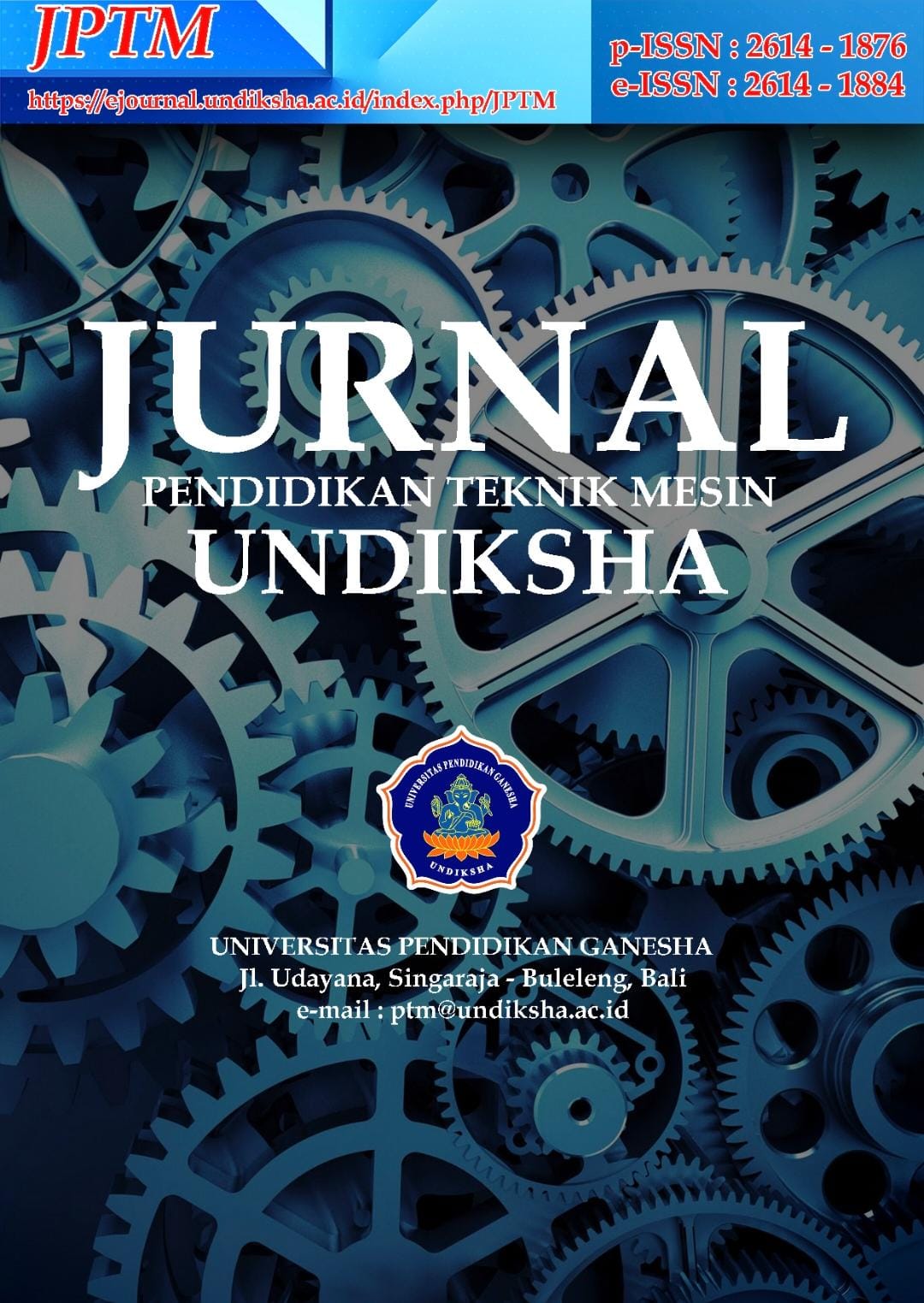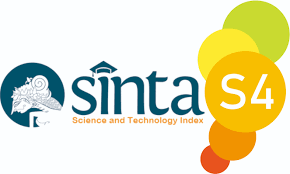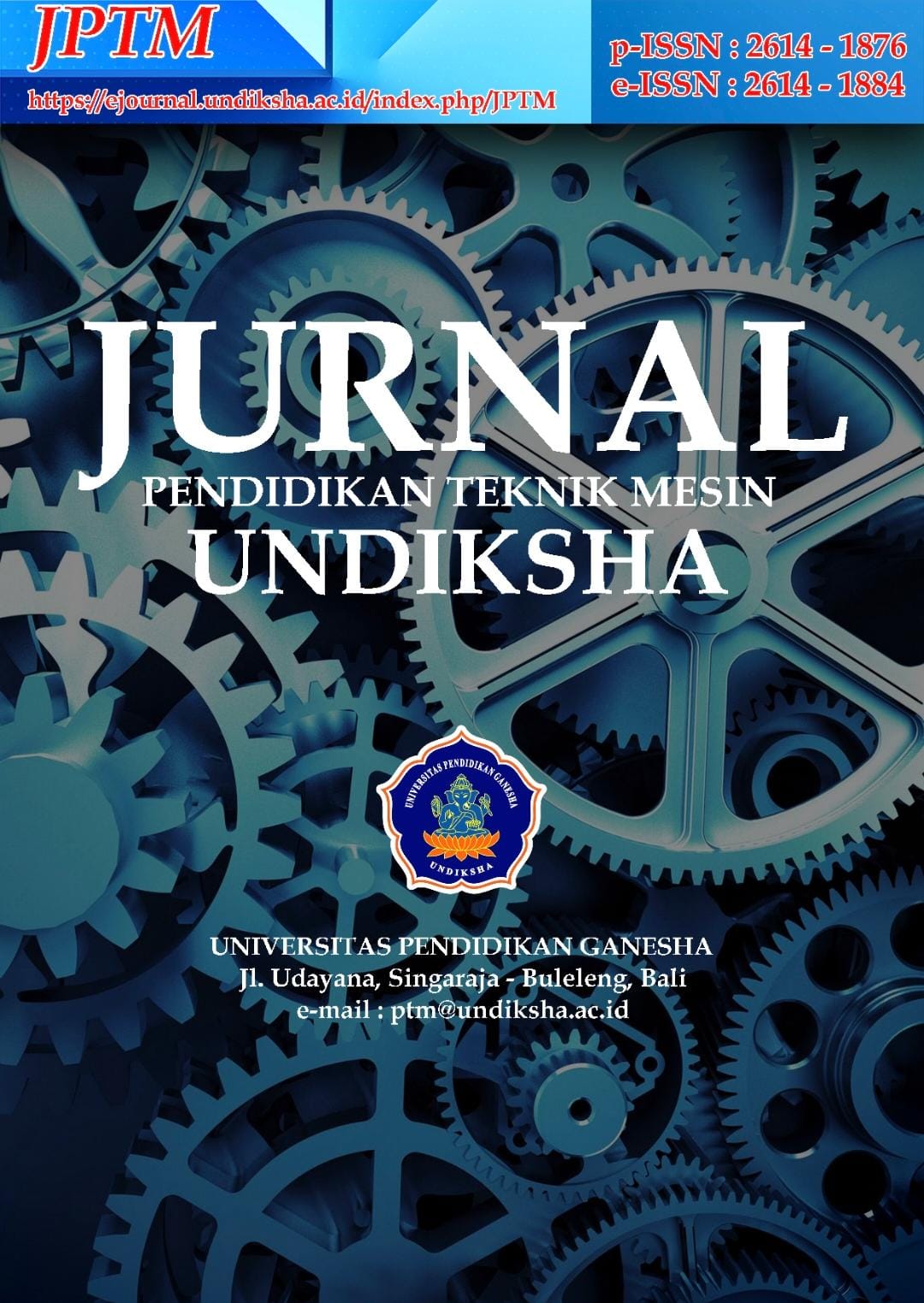Efektivitas Penerapan Software Swansoft CNC Simulation Terhadap Hasil Belajar Psikomotorik Siswa pada Elemen Teknik Pemesinan Nonkonvensional di SMK
The Effectiveness of The Application of Swansoft CNC Simulation Software to Students' Psychomotor Learning Outcomes on Nonconventional Machining Engineering Elements at SMK
DOI:
https://doi.org/10.23887/jptm.v13i1.91248Keywords:
Effectiveness, Psychomotor Learning Outcomes, Swansoft CNC Simulation SoftwareAbstract
This research aims to test the level of effectiveness of the application of swansoft simulation software in improving students' psychomotor learning outcomes in the elements of non-conventional machining engineering materials for CNC lathe operation materials at SMKN 4 Tangerang. This study uses a type of quasi-experimental design research method in the form of a noneequivalent control group design. The 54 students of SMKN 4 Tangerang phase F Machining for the 2024/2025 school year were used as research samples taken using the saturated sampling technique. The data collection technique in this study uses a performance test. The data analysis technique in this study used a normality test, a homogeneity test, and a test of the average similarity of students' initial ability, then the final analysis used the t-test and the n-gain test. The results of the study show that: 1) There was no significant difference in students' psychomotor learning outcomes between the experimental class that applied the swansoft simulation software and the control class that applied teaching aids in the form of CNC lathes as a learning medium, in the t-test analysis, it was obtained -t table (-2.007) ≤ t count (-0.1) ≤ t table (2.007); 2) The application of Swansoft CNC Simulation software is quite effective in improving the psychomotor learning outcomes of phase F students of Machining on non-conventional machining engineering elements of CNC lathe operation materials at SMKN 4 Tangerang, in the analysis of the n-gain test, the average n-gain value of the experimental class was obtained of 0.613 or 61.3%.
References
Abizar, H., Fawaid, M., Nurhaji, S., & Pambudi, A. R. (2020). Efektivitas Pembelajaran Praktik CNC menggunakan Swansoft Simulator pada Keaktifan Belajar Siswa. Taman Vokasi, 8(1). https://doi.org/10.30738/jtv.v8i1.7619
Baharuddin, R. Z. (2023). Penggunaan Modul Pembelajaran Teaching Factory (TEFA) Teknik Otomotif untuk Meningkatkan Pemahaman Peserta Didik di SMK.
Borich, Gary D. (2016). Observation Skill for Effective Teaching: Research-Based Practice. 7th. ed. New York: Routledge.
Br. Padang, Nurul Rahena, Maulana, Muhammad Firman, & Sembiring, Nurhaizan. (2020). Strategi Pembelajaran Aktif Knowledge Sharing dalam Kemampuan Psikomotorik pada Mata Pelajaran Fiqih. Jurnal Taushiah FAI UISU, 10(2), 137–147. https://jurnal.uisu.ac.id/index.php/tsh/article/view/3367/2337
Firdaus, F., Zulhajji, Z., A Karim, S., Yusuf Mappeasse, M., & Imran, A. (2023). Pelatihan Pembuatan Media Pembelajaran Berbasis Komputer bagi Guru SD di Kecamatan Salomekko Kabupaten Bone. Jurnal Pengabdian Masyarakat, 1(1), 23–28. https://doi.org/10.59562/abdimas.v1i1.298
Ghani, R. A. (2023). Penerapan Aplikasi GnaCAD 2D dalam Pembelajaran Gambar Teknik Berbasis Android untuk Siswa Sekolah Menengah Kejuruan (SMK).
Hake, R. R. (1999). Analyzing Change/Gain Score. Physics Indiana University.
Hikmawati, H., Kusmiyati, K., & Sutrio, S. (2020). Keterampilan Psikomotor Siswa dalam Melakukan Kegiatan Percobaan tentang Suhu dan Kalor menggunakan Media Tiga Dimensi dan Simulasi Komputer. Jurnal Penelitian dan Pembelajaran Fisika Indonesia, 1(1). https://doi.org/10.29303/jppfi.v1i1.11
Islami, N. Al, Hasanuddin, H., & Yunus, S. R. (2020). Implementasi Penggunaan Alat Peraga IPA untuk Meningkatkan Keterampilan Psikomotorik dan Hasil Belajar Peserta Didik Kelas IX di SMP Negeri 2 Marioriwawo. Jurnal IPA Terpadu, 3(2). https://doi.org/10.35580/ipaterpadu.v3i2.12405
Khoiroh, A. U., Rahayu, A. W., A'yun, A. Q., Rahman, M. R., & Rusydiyah, E. F. (2023). Identifikasi Penerapan Kerucut Pengalaman di Sekolah Dasar Kota Surabaya. Elementary: Jurnal Iilmiah Pendidikan Dasar, 9(1), 63-77. https://doi.org/10.32332/elementary.v9i1.6309
Ma’rufiati, T., Estriyanto, Y., & Siswandari. (2024). Enhancing Students’ Learning Outcomes Through Simulator Program: A Case Study of using Swansoft CNC Simulator Software in Vocational Education, 102–107. https://doi.org/10.2991/978-94-6463-445-7_12
Nanjing Swansoft Technology Company. (2024). SSCNC Introduction. http://www.swansc.com/en/products/SSCNC_outline.html.Diakses 18 Januari 2024.
Nuryadi, Astuti T. D., Utami E. S., & Budiantara M. (2017). Dasar-Dasar Statistik Penelitian. Yogyakarta: Gramasurya
Pradana, Muhammad Jefri, Samidjo, & Hadi Samsul. (2022). Meningkatkan Keaktifan dan Hasil Belajar pada Mata Pelajaran CNC melalui Aplikasi Swansoft CNC Simulator. Jurnal Vokasi Dewantara, 3(1), 83–88. https://doi.org/10.30738/jvd.vol3.no1.a9079
Sani, Ridwan Abdullah. (2013). Inovasi Pembelajaran. Jakarta: Bumi Aksara.
Sanjaya, Wina. (2022). Perencanaan dan Desain Sistem Pembelajaran. Jakarta: Kencana Prenada Media.
Sugiyono. (2019). Metode Penelitian Kuantitatif, Kualitatif, dan R&D. Bandung: Alfabeta.
Downloads
Published
Issue
Section
License

This work is licensed under a Creative Commons Attribution-ShareAlike 4.0 International License.

Jurnal Pendidikan Teknik Mesin Undiksha is licensed under a Creative Commons Attribution-ShareAlike 4.0 International License.










